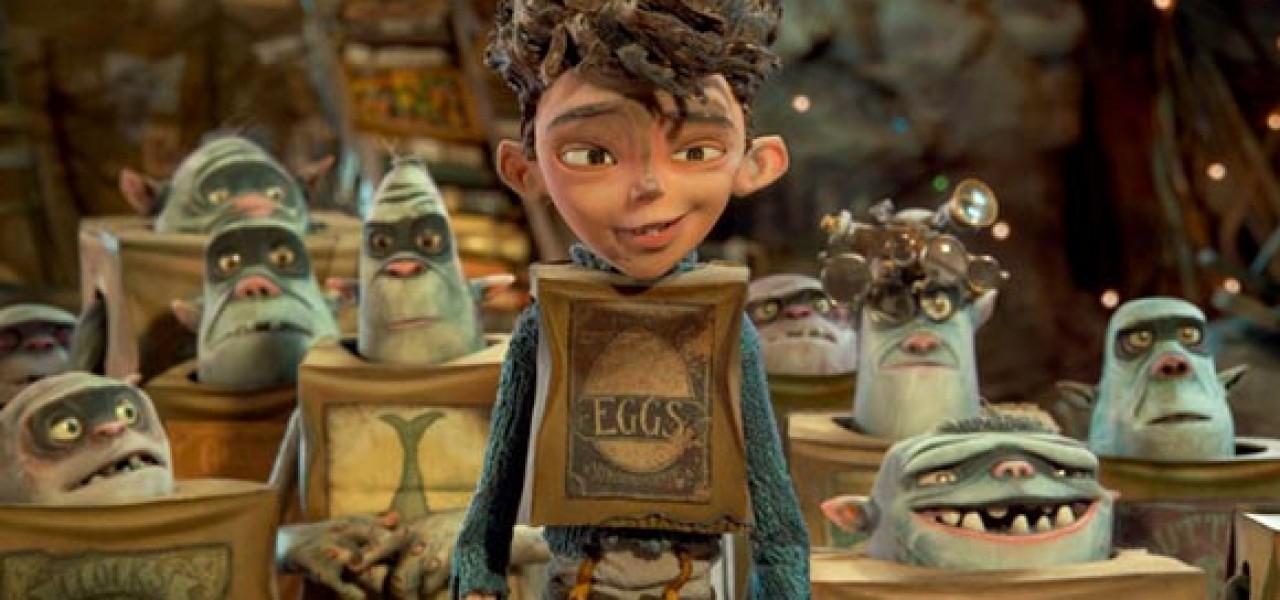
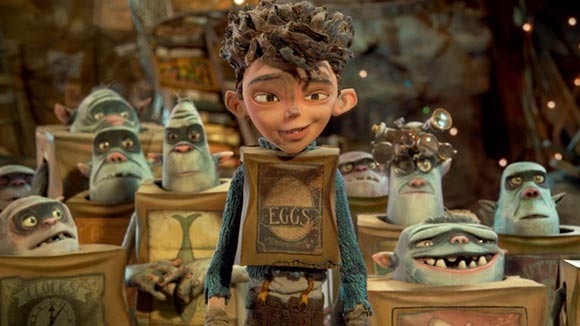
Oscar Ballot Guide: ‘The Boxtrolls’ Acting and Performance Analysis
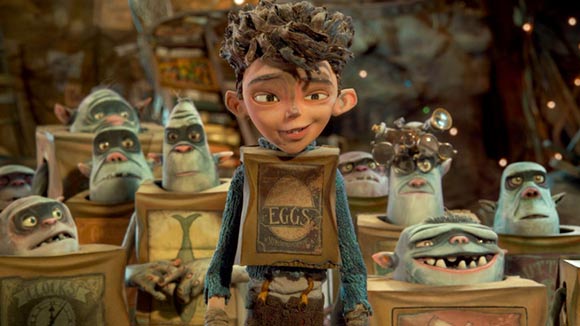
Part three of a five-part series in which Ed Hooks, author of Acting for Animators, does an acting and performance analysis of this year’s five Academy Award-nominated animated features.
Read his analysis of The Tale of The Princess Kaguya and How to Train Your Dragon 2.
The humor in Laika’s The Boxtrolls is of the more-is-funnier variety, which makes most of it non-empathetic. It begins during the film’s introductory sequence (8:35 – 9:46 iTunes time code) when we see two Boxtrolls named Sparky and Bucket repairing a discarded toaster. It is a set-up for an electrical-shock gag, but look closely at how the joke is being handled. One table fork stuck inside a plugged-in toaster would be enough to get an individual shocked, but these animators have inserted what looks like twelve different metal objects. I see an egg whisk, a screwdriver, maybe some pliers, and a few other makeshift tools. The performance thinking is that: If one metal-object-in-toaster is funny, then eight metal-objects-toaster is funnier.
Comedy is a factor of man’s limitations in life, and the joke here is that, at one time or another, we all stick a metaphoric table fork in a metaphoric toaster. We humans are insanely fallible, making bad choices all the time. We are the only animal, in fact, that can know something is bad or harmful to us, and still do it anyway. We make unfortunate choices in life and then we die anyway. Human laughter is an “I’m okay, you’re okay” kind of thing, a social celebration of us not being dead yet. In order to make this electric shock gag work, it was only necessary to insert a single metal object into the top of the toaster. Then, when it predictably shocked one of the Boxtrolls, he would sheepishly play his embarrassment off against the other Boxtroll’s arrogant derision.
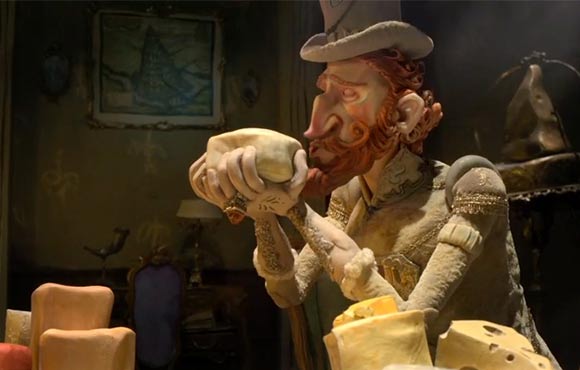
Another example of more-is-funnier thinking is the way Winnie’s relationship with her father is presented. The idea was to show that Lord Portley-Rind places a higher value on his white hat and the relationship he maintains with his cronies than he does on his relationship with his daughter. But empathy was totally tossed out the window by having him treat Winnie cruelly (21:46 – 23:51).
When Portley-Rind grabs his white hat from Archibald Snatcher, he ignores Winnie, practically shoving her aside. It would have worked better if he had passively acknowledged her, maybe smiled insincerely and then pushed her aside in favor of the hat. We need to see Portley-Rind make choices so that we can learn about his personal values. The way he is presented in this sequence, he seems oblivious to his daughter, which is neither funny nor illuminating.
Everybody in the audience knows that parents are hard-wired by nature to be mindful of their children, so Portley-Rind’s behavior feels puzzling at best and rings untrue at worst. Then after Winnie tells him moments later that she is afraid of the Boxtrolls and wants to “talk about feelings,” he turns his back on her, slamming the door in her face as if she is an annoying street peddler. My impression is that the directors intended this to be an amusing way to introduce some backstory regarding white hats, but it only succeeds in alienating the audience, and is, again, a missed opportunity.
Portley-Rind is making bad choices in life, and that point will be diluted in the payoff if we do not get to see him making choices in the first place. As a general acting note, you want to be very careful about having a character think, in essence, “I don’t care”, which is what Portley-Rind is doing here regarding Winnie.
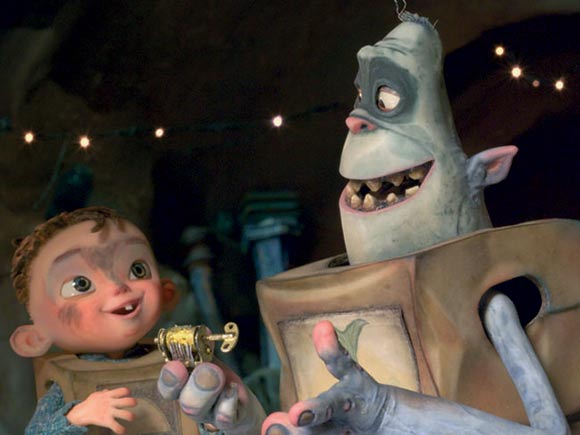
When they want to establish a sense of empathy in a sequence, the directors do it with aplomb. The relationship between infant-Eggs and the Boxtroll named Fish, for instance, works nicely. At 10:23 – 11:10, Fish plays hide-and-seek games with Eggs. Words are unnecessary to evoke our emotion as Fish behaves like a loving and attentive parent, completely in the moment with the child. The word “empathy” literally means “feeling into.” When Fish plays with Eggs, we recognize the emotions and relate to them.
11:38 Baby Eggs time-lapses into an eleven or twelve year old boy. It would have been helpful if we had simultaneously seen the Boxtrolls getting older because it would have suggested a Boxtroll life cycle. The movie doesn’t do much to explain how Boxtrolls reproduce, age, and die. There aren’t any female Boxtrolls that I can see, and the only food Boxtrolls apparently eat is live insects.
Somehow, even though they speak a unique Boxtroll language, Eggs has become proficient in spoken English rather than Boxtroll-ese. The only explanation is given forty-five minutes into the film when Eggs says his language skills are the result of “a speech impediment.” That explanation makes zero sense and was probably tossed in as a kind of joke. My point is that this movie’s screenplay glaringly and frustratingly leaves a lot of dangling loose ends. The directors evidently did not think it matters, which strikes me as an error.
The aesthetics of film is a big subject all by itself, but an early lesson is that the audience presumes one hundred percent of what is shown – or not shown — on screen is there or not-there for a reason. Audiences do not easily overlook on-screen omissions. When a lot of information is left out, as is the case in this screenplay, it can be construed as directorial arrogance and condescension. We don’t see the Boxtrolls getting older or mating, and we are given no explanation at all for their life cycle, which leaves the audience feeling incomplete and dissatisfied on some level. We see Boxtrolls being sad, but we don’t see them being mortal.
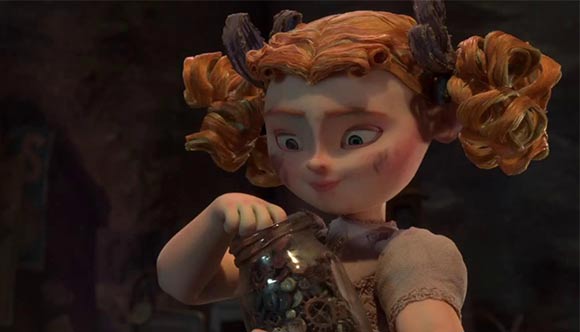
Winnie is the most normal, psychologically healthy character in the story, but how she got to be that way is a mystery because she has an absentee mother and an oddball, emotionally dysfunctional father. Winnie functions as the story’s protagonist although this is Eggs’s story. Her performance, while not awe-inspiring, is at least consistent. She always plays actions in pursuit of provable objectives while overcoming obstacles. She is the one that causes Eggs to acknowledge he is a human boy and not a boxtroll. (45:53 – 48:06) She is the one that saves Eggs from being incinerated (1:14:51 – 1:15:41), and during a brief convenient moment, convinces Mr. Trout and Mr. Pickles that they “don’t have to do this”, that they don’t have to be villains at all. (1:15:40)
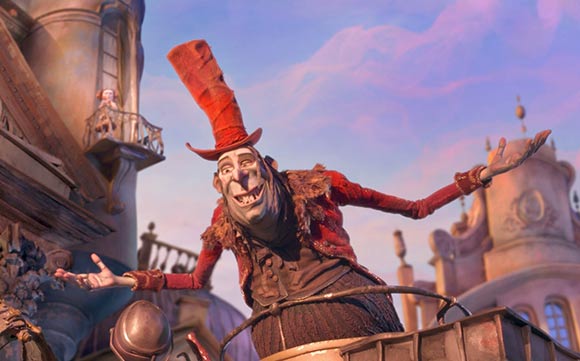
The story’s villain, Archibald Snatcher, is another example of more-is-funnier thinking. He is written as a one-dimension, single-minded villain, an ambitious sociopath who has no qualms about killing and maiming any character that he encounters. That would seem to be enough for a cartoon villain but, in an attempt to be extra funny – and perhaps because they had x-millions of possible 3D printer facial expressions to play with—the directors kicked Snatcher up a notch, turning him into a drag queen known as Madame Frou Frou.
In the process, they went ahead and endowed Lord Portley-Rind with unjustified sexual ambiguity, giving him a titillating thing for the madame. This element also raises the question of the intended audience for the movie. Little kids will be amused when Eggs and his Boxtroll family eat bugs, but what will they make of Portley-Rind’s libido?
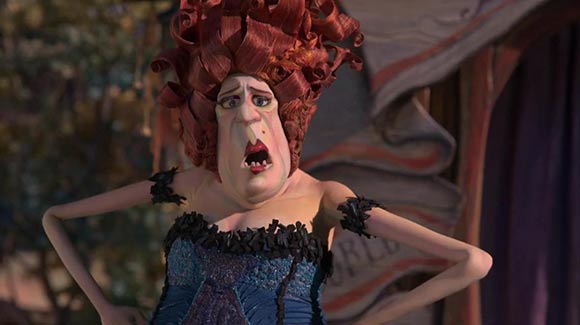
From an acting perspective, Snatcher’s finest moment comes just prior to his death, at 1:24:00. His facial features are grotesquely distorted by his cheese allergy. Common sense for most people would dictate that he eat no more cheese. But emotion is driving Snatcher at this point, nothing but emotion. He wants to eat one last, exquisite bite of cheese. He knows he should not eat it, and so he has conflict with himself and his situation. We can literally see him sweating (1:24:32) from the exertion of his will. He achieves his objective while forfeiting his life. At 1:25:07, he explodes. Very nice sequence performance-wise, emotionally satisfying, and for the first time in the film, a moment of empathy.
My focus in these animated feature analyses is on performance, but the fact is that acting cannot be separated from story. If it isn’t in the script, the animators can’t fix it. The Boxtrolls sceenplay is a big puzzle because it contains so much unjustified visual enrichment, and the action feels contrived. That is why the characters are generally non-empathetic.
From bug-eating to box-wearing to gibberish-language-speaking, the Boxtroll characters are a kind of visual joke and not much more. They hammer, saw, tweet, hiccup, spin and pound, creating Rube Goldberg contraption machines that have no clear purpose or function. By the end of the movie, we really do not know the Boxtrolls much better than we did when they were first introduced, and that is a script issue, not a performance issue.
The human characters which, as representatives of our own species, should be the ones we most identify with, are garishly colorful stereotypes that barely relate to one another in civil ways. In other words, the entire creature-human universe as presented in The Boxtrolls is an empty shell. There is no there there. We spend ninety minutes with them and learn nothing about life.
ED HOOKS is the author of Acting for Animators, (revised third edition, Routledge, 2011). Ed pioneered Acting for Animators in 1998 while working with the animators at PDI/DreamWorks in northern California, and teaches the Acting for Animators masterclass internationally. For Cartoon Brew, he previously wrote a performance analysis of Disney’s Frozen. For more information about his practice, visit EdHooks.com

.png)